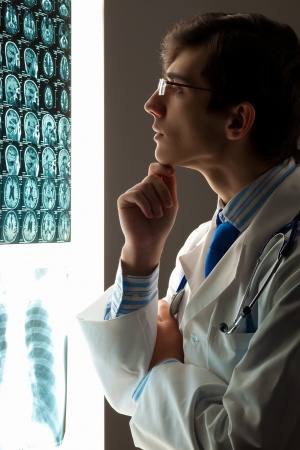 Science used to believe that once a person had reached adulthood, the brain stopped growing. The thought was that, regardless of changes in stimuli, connections between neurons were stable and unchanging. Under this model, an injured or diseased brain would incur irreparable damage.
Science used to believe that once a person had reached adulthood, the brain stopped growing. The thought was that, regardless of changes in stimuli, connections between neurons were stable and unchanging. Under this model, an injured or diseased brain would incur irreparable damage.
But we now know this not to be exactly true.
Although a significant brain injury— due to trauma or stroke— or advanced degenerative changes caused by cognitive disorders like Alzheimer's or Parkinson's can result in large scale loss of function, evidence seems to indicate that the brain is indeed able to re-route functions and re-wire itself, at least to some extent, in order to recover.
This ability of the brain to re-map and form new neural connections is called neuroplasticity. And for scientists who study neurological diseases, and for the doctors who treat them, it is critically important to determine just how flexible the human brain can be.
It is also important for any senior whose lifestyle is affected by memory or motor deficiency— if methods can be developed to increased neuroplasticity in the elderly brain, these individuals will be able to live longer, more fulfilling lives.
Here are three key facts you should know about neuroplasticity and what it means for your continuing care:
1. There are two types of neuroplasticity.
Functional neuroplasticity is the brain's ability to shuffle responsibility for a particular function from one area of the brain to another after the primary area of responsibility becomes damaged or diseased.
Functional neuroplasticity was the focus of a study published earlier this year by researchers at the University of Delaware, who found that even those patients who are remotely status post-stroke can redevelop sensation in affected limbs.
The sense of touch is normally processed in the parietal lobe, located along the side of the brain. If a stroke damages the parietal region, a part of the body may go numb— typically a limb or both limbs on the opposite side of the body from the side of the brain in which the stroke occurred.
In the UD study, researchers noted that patients who had recovered sensation after having had a stroke did not always register that sensation in the exact spot where stimulus was applied. A touch on the hand, for example, may have been experienced as a touch further up the arm, when the patient kept his or her eyes closed. This, the study's author's said, is indicative of functional re-mapping within the brain.
Encouragingly, they believe that such re-mapping could be harnessed— once the mechanism is better understood — to better help stroke patients to recover lost senses.
Structural neuroplasticity, however, involves the brain not just reassigning functions, but physically re-growing disrupted synapses (connections between neurons) or developing entirely new connections.
The brain is one of only a few organs in the human body— the others being the liver and spleen— capable of any physical regeneration at all, though exactly how the brain repairs itself is not well understood.
The question most researchers have is whether or not that regenerative capacity is limited or if it can be harnessed to "grow back" areas of the brain that have been irreparably damaged.
2. Even healthy brains change in response to repeated stimuli.
Just as a muscle becomes bigger and tighter-knit when it is repeatedly used to lift a weight, the brain will naturally "beef up" areas that are called into action more frequently.
A 2006 study published in the neuroscience journal Hippocampus showed that London taxi drivers, who must be able to distinguish between landmarks and navigate complex routes every day in their work, have enlarged mid-posterior hippocampi— the region of the brain that is responsible for processing spatial relations.
Interestingly, driving around does not, in and of itself, seem to be the cause of this increased spatial processing capacity.
When compared to bus drivers who, similarly, navigate routes every day, taxi drivers in the study had larger hippocampi. This, the study posited, is likely due to the fact that taxi drivers' routes are constantly changing. A taxi driver must be able to pre-plan his or her route to a near-infinite amount of destinations from a near-infinite number of starting points. To do so, he or she must store and recall a more robust "virtual map" than would a bus or casual driver.
3. Your brain can "dial up the volume" for areas of the brain that need to work harder.
Neuroplasticity doesn't always involve long-term changes in the brain, either. The brain can temporarily modify the extent to which one area functions over another. Like a studio engineer increasing the gain on a particular sound frequency when mixing a song, the brain has an internal "switch" that can cause some neurons to fire more frequently than normal in response to stimuli.
In a study published earlier this year in another neuroscience journal, Cell, researchers found that vasoactive intestinal peptide (VIP) neurons could sense the movement of a mouse running on Styrofoam ball that was suspended by a jet of air.
Due to the precarious balance the mice were forced to maintain, the VIP neurons in turn initiated a cascade of signals that caused the visual cortexes— areas responsible for processing incoming sights— in the mice to fire more quickly.
The researchers speculated that the VIP switch could be a pathway that might be stimulated in order to help the brain to restore long-term function in damaged, diseased, or underdeveloped regions of the adult brain.
The search to understand neuroplasticity may yield better treatments for cognitive disorders.
As such, it is an important area of interest to geriatricians, senior health care providers and senior lifestyle experts. The brain's ability to rewire and shuffle functions may yet be harnessed to help patients heal after devastating brain injuries, or to preserve memory longer into advanced adulthood.












